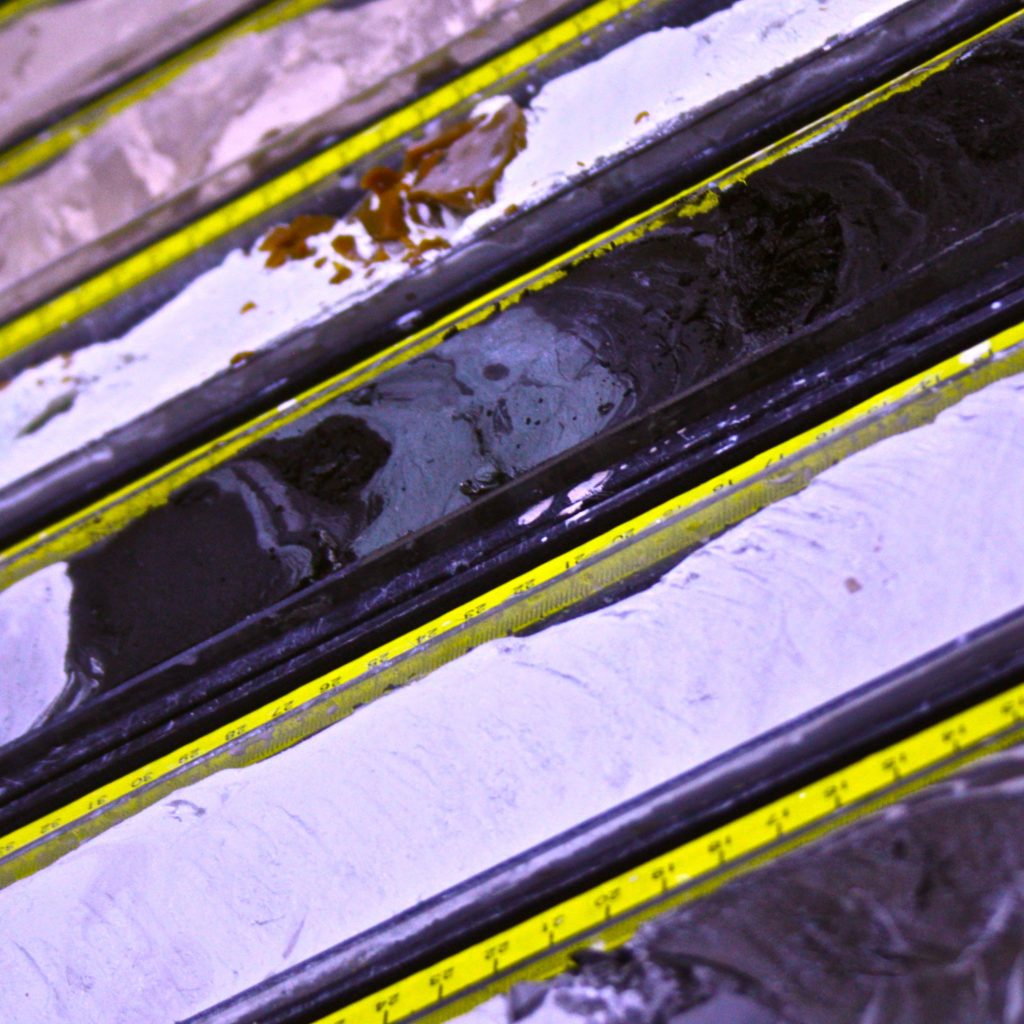
Science Party Guest Post: Chris Junium – OAE 2
Despite the swell, showers and clouds, the sun seems to be shining on JOIDES Resolution the past few days (knocking on wood right now). We have recovered treasured carbonate-rich Paleogene Sediments, as predicted, and not a hint of the ‘Green Monster’. To be sure, the Eocene is great but Site 1407 yielded a most unexpected treasure. The plan was that we would dip the end of the drill string into the Cretaceous at the bottom of the borehole. What we had not foreseen was a full-on swan dive through the Late Cretaceous that was highlighted by a wonderful record of the Cretaceous, Cenomanian-Turonian Oceanic Anoxic Event 2, or ‘OAE 2’ as it is know to those in the paleoceanography community.

Expedition 342’s science party taking a closer look at one of the OAE cores.
OAEs are geologically short intervals of time (typically 100,000 to 1,000,000 years) characterized by widespread lack of oxygen (anoxia) in the ocean and perturbation of the carbon cycle on a global scale. OAEs are recognized by the presence of black, organic matter-rich claystones called black shales. In the case of OAE 2, we find black shales of Cenomanian-Turonian age distributed in many places globally, but the geochemical fingerprint of carbon burial (stable isotopes of carbon) is consistent with a global event of massive proportions. So how is it that black shales, anoxia and the geochemical signature of organic carbon burial occur so widely?
The current understanding of OAE 2 is that it was a response to warming from the rapid addition of carbon dioxide to the ocean-atmosphere system. In this sense, OAEs are similar to the Eocene ocean acidification / hyperthermal events that are one of the primary targets of the 342 Expedition. However, the Earth system responded to CO2 addition in the mid-Cretaceous in a way that was distinctly different from the Eocene dissolution of calcium carbonate followed by high rates of carbonate production (the overshoot). The Cretaceous Ocean rapidly sequestered the extra carbon dioxide as organic matter. The curious thing about carbon dioxide added to the atmosphere is that over long time-scales it fuels its own removal through a series of linked events and feedbacks that fertilize the ocean and can result in an Ocean Anoxic Event:
- Carbon dioxide addition resulted in warming
- Warming enhanced the hydrologic cycle (think more rain in rainy places)
- More rain plus higher CO2 increased the dissolution of rocks on land (weathering).
- Rocks contain small amounts of phosphorus, one of the most important nutrients limiting life in the ocean, but a little phosphorus goes a long way.
- Phosphorus was delivered to the ocean by rivers, stimulating organic productivity (mostly algae and bacteria) in many areas of the ocean.
- That algal organic matter is consumed by bacteria that use oxygen (just like humans)
- All of the oxygen is consumed and the water column became anoxic
- Anoxia limited the degradation of organic matter and allowed for deposition of the organic matter-rich black shales that we see in the Expedition 342 sediments.
- Over the duration of the OAE (~400,000 years), the organic matter being buried removed the excess CO2 from the atmosphere allowing the Earth to cool and weathering rates to decrease.
- With less phosphorus being added to the ocean and cooler temperatures the OAE ends.

The characteristic black shale.
So you can simply think of Oceanic Anoxic Event 2 as a fertilization event that removed the excess CO2 as organic matter. OAEs happened several times through the Jurassic and Cretaceous, and black shales are more common during this interval of time. This is due, in part, to the small size, relatively shallow depth and style of ocean circulation that characterized the Mesozoic Atlantic Tethys (Mediterranean) Ocean. As the Atlantic Ocean basin opened through the Cretaceous, ocean circulation became less conducive to anoxia, and the Oceanic Anoxic Events became a thing of the past.
